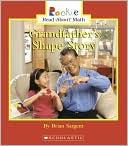 Murphy, Stuart J.
Murphy, Stuart J.Circus Shapes (MathStart Series).
1998.
HarperCollins Publishers.
Review copy borrowed from local library.
Guided Reading Level: H
Teaching children about shapes can prove to be a bit more difficult that it might ordinarily seem! The use of an interesting topic to show them shapes in an everyday way is exactly what you'll probably need! Here, Stuart J. Murphy introduces many everyday shapes by taking readers to the circus. Circus animals perform a variety of tricks, all of which result in the production of different shapes.
While not all of the shapes found in a tangram puzzle are presented in this book, the book does serve as a perfect introduction or review of many basic shapes. The last two pages also invite readers to search for different shapes as a way to reinforce the shapes (circles, triangles, rectangles, squares) that have been mentioned throughout.
Reading/Learning Activities:
- Test your child(ren)'s knowledge of and understanding of circles, squares, rectangles and triangles by asking them to count the number of each that make up "Tango the Clown."
 Sargent, Brian.
Sargent, Brian.Grandfather's Shape Story.
2007.
Scholastic, Inc.
Review copy borrowed from local library.
A little girl is introduced to tangrams through her grandfather's "Shape Story." As the story goes, a poor man in a far away country found pleasure in life's simple things. One day, as he was sitting around, the man heard someone calling for help - a rooster, seeking shelter from a troublesome fox. The man took in the rooster to his home, closing the windows and using only candlelight to see. Together, the two sit at a table, the man drinking tea. The rooster is so thankful for the man saving his life, he wants to grant the man one wish. The man thinks and thinks about what his one wish should be. However, rather than actually revealing the wish to his granddaughter, he passes the tangrams along and tells her you choose, encouraging the little girl be creative with creating something from the tangrams.
This book is ideal to use when introducing tangrams to children for many reasons. First, the tangram puzzle is introduced as a "whole" square, but all of the different shape pieces can be detected due to their coloration. Secondly, the pieces of the tangram puzzle are separated and labeled so children have the opportunity to become familiar with the shapes. Finally, all of the illustrations are made from colored tangrams, allowing children to visibly see the how different shapes put together can "form" objects.
Learning/Reading Activity:
- Print off the tangram puzzle, found here. I would suggest printing the puzzle on cardstock or heavy weight printer paper so it is more durable.
- Have your child color the puzzle using the following directions: 1 large triangle red, 1 large triangle blue, 2 small triangle red, 1 small triangle blue, 1 medium triangle yellow, 1 parallelogram yellow, 1 square green.
- Using page 6 of Grandfather's Shape Story, help your child label each of the pieces of the tangram puzzle. This will allow them to become familiar with the different shapes.
- Allow your child(ren) to experiment with the tangram pieces - encourage them to play around with the shapes and see what they can "make." Allowing them freedom to explore the "tools" freely some will ensure that when you do try to use the tangrams educationally, they will be less apt to "play" while you're teaching!

If you're interested in finding out more information about any of the books reviewed or if you'd like to purchase the books, click the cover image for a link to Amazon.com. I am an Amazon Affiliate, so any purchases you make after clicking these images will result in my receiving a small percentage of the sale price!








0 comments:
Post a Comment